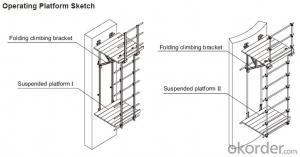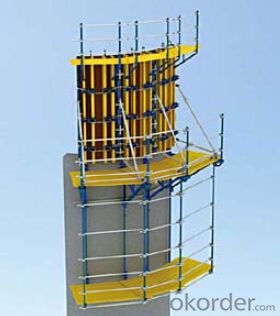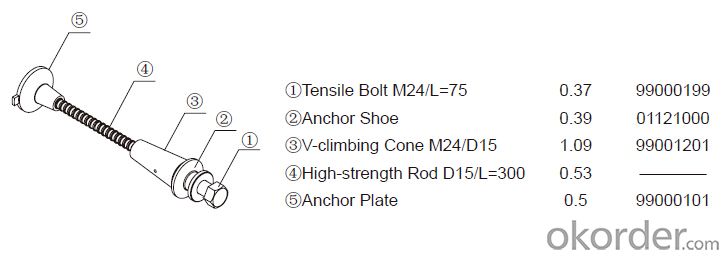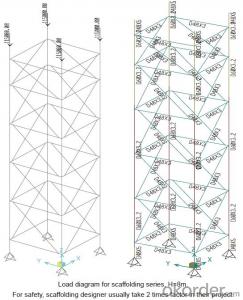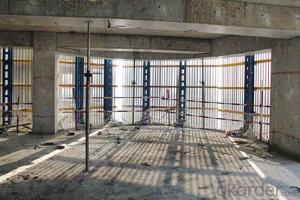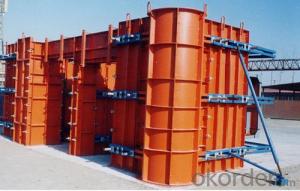Climbing-Platform CP190 for Formwork and Scaffolding system
- Loading Port:
- Tianjin
- Payment Terms:
- TT OR LC
- Min Order Qty:
- 50 m²
- Supply Capability:
- 1000 m²/month
OKorder Service Pledge
OKorder Financial Service
You Might Also Like
Climbing Platform CP190
Climbing bracket CP190 is mainly used as operating platform during construction. It can be used
on the vertical wall and arced wall. The bracket hang on the anchor system and all the load are
supported by anchor system. It’s convenient to assemble and dismantle, the construction is easy,
rapid and safe.
Anchor System:
Anchor system is the most important supporting part. The system is made of five parts shown
below. There into, tensile bolt, anchor shoe and V-climbing cone can be taken out for reusing.
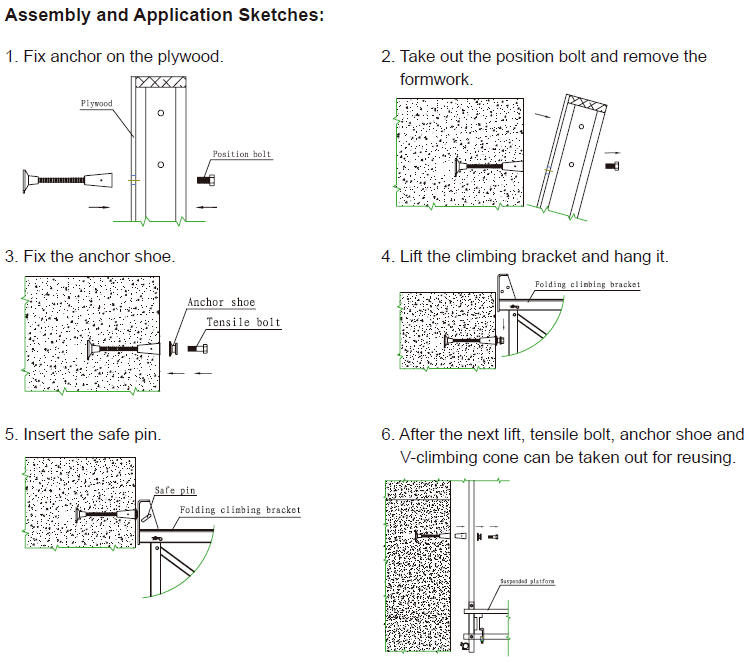
- Q: Can steel formwork be used for both horizontal and vertical construction elements?
- Yes, steel formwork can be used for both horizontal and vertical construction elements. Steel formwork is versatile and can be easily adapted to different shapes and sizes, making it suitable for various construction applications.
- Q: What are the different types of formwork connectors used in steel formwork?
- There are several types of formwork connectors that are commonly used in steel formwork systems. These connectors play a crucial role in ensuring the stability and strength of the formwork structure. Some of the different types of formwork connectors used in steel formwork include: 1. Wedge Lock Connector: This type of connector is widely used in steel formwork systems. It consists of two separate pieces – a wedge and a lock. The wedge is inserted into the formwork joint, and the lock is then inserted to secure the wedge in place. This connector provides a tight and secure connection, which helps in maintaining the formwork's stability. 2. Pin and Wedge Connector: This connector comprises a pin and a wedge. The pin is inserted through the holes in the formwork panels, and the wedge is then driven into the hole, securing the pin in place. The pin and wedge connector is easy to install and provides a strong connection between the formwork panels. 3. Rapid Clamp Connector: This type of connector is designed to quickly and securely connect steel formwork panels. It consists of a clamp that is tightened around the formwork panel, providing a reliable and sturdy connection. The rapid clamp connector is often used in applications where a quick assembly and disassembly of formwork is required. 4. Hook and Loop Connector: This connector utilizes a hook and loop fastening system to connect the formwork panels. The hook and loop strips are attached to the edges of the formwork panels, allowing them to be easily and firmly connected. This type of connector is commonly used in applications where frequent adjustments or reconfigurations of the formwork are needed. 5. Magnetic Connector: This connector uses magnets to securely connect the steel formwork panels. The magnets are embedded within the formwork panels, allowing them to easily snap together. The magnetic connector is known for its quick installation and disassembly, making it ideal for projects with tight schedules. These are just a few examples of the different types of formwork connectors used in steel formwork. Each connector has its own unique features and benefits, and the selection of the appropriate connector depends on the specific requirements of the project and the formwork system being used.
- Q: How does steel formwork affect the overall construction site safety measures?
- Steel formwork can have a significant impact on the overall construction site safety measures in several ways. Firstly, steel formwork is known for its high strength and durability, which ensures stability and structural integrity during the construction process. This reduces the risk of accidents such as collapses or structural failures, enhancing the safety of workers and the site as a whole. Additionally, steel formwork offers better fire resistance compared to other types of formwork materials. This characteristic can prevent or slow down the spread of fire, providing extra time for workers to evacuate the site safely and for emergency services to respond effectively. It also reduces the risk of fire-related accidents, protecting both human lives and the surrounding environment. Another safety benefit of steel formwork is its ability to withstand extreme weather conditions, such as strong winds or heavy rain. This resilience reduces the likelihood of formwork damage or failure, ensuring the safety of workers and preventing potential accidents caused by adverse weather. Furthermore, steel formwork is often designed with built-in safety features, such as handrails and platforms, to provide secure working surfaces for construction workers. These features allow workers to perform their tasks safely at heights, reducing the risk of falls and injuries. Lastly, steel formwork is reusable and requires minimal maintenance, which contributes to the overall site safety. The use of reusable formwork reduces waste and clutter, creating a cleaner and more organized working environment. This, in turn, minimizes the risk of accidents caused by tripping or falling over debris. In conclusion, steel formwork positively affects the overall construction site safety measures by providing stability, fire resistance, weather resistance, built-in safety features, and a cleaner working environment. These benefits reduce the risk of accidents, ensure the safety of workers, and contribute to the successful completion of construction projects.
- Q: How does steel formwork contribute to the strength and stability of a concrete structure?
- Steel formwork is a critical component in the construction of concrete structures as it plays a crucial role in enhancing their strength and stability. One of the key ways in which steel formwork contributes to this is by providing a robust framework for the concrete to be poured into and cured. The steel formwork acts as a mold or a template that holds the liquid concrete in place until it solidifies. This ensures that the concrete takes the desired shape and form, resulting in a structurally sound and stable structure. Furthermore, steel formwork provides support and reinforcement to the concrete during the curing process. As the concrete hardens, it exerts pressure on the formwork. The high tensile strength of steel allows it to withstand and distribute these forces evenly, thereby preventing any distortion or collapse of the structure. This is particularly important in the case of large-scale or complex structures where the concrete needs to be supported over extended periods. In addition, steel formwork facilitates the proper alignment and leveling of the concrete during the construction process. The rigid nature of steel ensures that the formwork remains in place and maintains its shape, resulting in accurate dimensions and a uniform finish. This contributes to the overall strength and stability of the concrete structure by eliminating any irregularities or weaknesses that may arise from inaccuracies in the formwork. Moreover, steel formwork can be easily assembled and disassembled, allowing for efficient construction processes. This flexibility enables faster construction timelines, minimizing the exposure of the concrete to external elements and reducing the risk of structural damage. The ability to reuse steel formwork also makes it a cost-effective solution for multiple construction projects. Overall, the use of steel formwork significantly enhances the strength and stability of concrete structures by providing a sturdy framework, supporting the curing process, ensuring accurate alignment, and facilitating efficient construction practices. Its durability, strength, and versatility make it an essential component in the construction industry, contributing to the creation of safe and reliable concrete structures.
- Q: How does steel formwork affect the overall moisture resistance of the structure?
- Steel formwork does not directly affect the overall moisture resistance of the structure as it is primarily used as a temporary mold for concrete placement. However, if not properly sealed or if there are gaps between the steel formwork and the concrete, it can potentially lead to water infiltration and compromise the moisture resistance of the structure.
- Q: Can steel formwork be used for circular columns?
- Certainly, circular columns can be constructed using steel formwork. Steel formwork possesses great versatility and can be conveniently molded into different shapes and sizes, including circular structures. Its exceptional strength and durability make it ideal for projects requiring formwork that can withstand substantial loads and frequent utilization. Moreover, steel formwork can be easily modified and utilized repeatedly, resulting in cost-effective circular column construction. Typically, the steel formwork is meticulously designed and produced to perfectly align with the precise dimensions and radius of the circular column, guaranteeing an exact and precise formwork system.
- Q: Can steel formwork be used for road construction?
- Yes, steel formwork can be used for road construction. Steel formwork is a popular choice for road construction projects due to its durability, strength, and versatility. It is capable of withstanding heavy loads and pressure, making it suitable for creating sturdy and long-lasting road surfaces. Steel formwork can be easily assembled and disassembled, allowing for efficient construction processes and faster project completion. Additionally, steel formwork can be reused multiple times, making it a cost-effective option for road construction.
- Q: What are the different sizes and dimensions of steel formwork?
- Steel formwork is available in various sizes and dimensions to cater to different construction requirements and project needs. The most common sizes of steel formwork panels are typically 2 meters (6.5 feet) in height and 1 meter (3.2 feet) in width. However, these dimensions can vary depending on the manufacturer and the specific project requirements. In terms of thickness, steel formwork panels are usually between 12 to 14 millimeters (0.5 to 0.6 inches) thick. This thickness ensures the panels are sturdy enough to withstand the pressure exerted by the concrete during the pouring and curing process. Additionally, steel formwork panels are available in various lengths to accommodate different wall heights and dimensions. These lengths can range from 1 meter (3.2 feet) to 4 meters (13.1 feet) or even longer, depending on the project requirements. Apart from panels, steel formwork systems also include other components such as beams, props, adjustable struts, and connectors. These components come in different sizes and dimensions to support the formwork structure and ensure stability and safety during the construction process. It is important to note that the dimensions and sizes of steel formwork can vary depending on the manufacturer, project specifications, and regional construction practices. Therefore, it is crucial to consult with the manufacturer or a structural engineer to determine the appropriate sizes and dimensions of steel formwork required for a specific construction project.
- Q: Is steel formwork suitable for projects with high concrete strength requirements?
- Yes, steel formwork is suitable for projects with high concrete strength requirements. Steel formwork is known for its high strength and durability, making it ideal for projects that require high concrete strength. It can withstand the pressure and weight of the concrete, ensuring that it maintains its shape and stability during the pouring and curing process. Additionally, steel formwork provides a smooth and uniform finish to the concrete, which is important for achieving high strength and quality in the final product. Moreover, steel formwork can be easily reused multiple times, making it a cost-effective option for projects with high concrete strength requirements.
- Q: What are the considerations when designing a steel formwork system?
- When designing a steel formwork system, there are various important factors that must be taken into account. These factors encompass: 1. Ensuring Structural Integrity: It is crucial to design the steel formwork system in a manner that guarantees sufficient structural integrity to withstand the loads and pressures exerted by the wet concrete during pouring and curing. This entails preventing any deformation or failure, as well as considering the appropriate thickness and reinforcement of the steel components. 2. Prioritizing Durability: The formwork system should be designed with durability and longevity in mind, as it will undergo multiple uses and may need to be reused for different construction projects. The steel used should be resistant to corrosion, and all components should be adequately coated or protected to prevent rust and deterioration over time. 3. Emphasizing Flexibility and Adaptability: The design of the steel formwork system should allow for flexibility and adaptability to meet different construction requirements. This includes considering the ability to easily adjust the formwork to accommodate various shapes, sizes, and configurations of concrete structures. The system should also enable straightforward assembly, disassembly, and reconfiguration to facilitate efficient and cost-effective use. 4. Ensuring Safety: Safety is paramount when designing a steel formwork system. The design should incorporate appropriate safety features, such as guardrails, handrails, and non-slip surfaces, to prevent accidents and ensure the well-being of workers. Additionally, the formwork system should be designed to minimize the risk of concrete blowouts or collapses, and measures should be implemented to ensure the stability and rigidity of the system. 5. Considering Cost-effectiveness: The overall cost-effectiveness of the steel formwork system should be evaluated during the design phase. This involves assessing the initial cost of materials and fabrication, as well as the potential for reuse and ease of maintenance. The design should strive to minimize waste, maximize efficiency, and ultimately provide a cost-effective solution for the construction project. In conclusion, when designing a steel formwork system, it is essential to consider factors such as structural integrity, durability, flexibility and adaptability, safety, and cost-effectiveness. By addressing these considerations, a well-designed steel formwork system can contribute to the successful and efficient completion of a construction project.
Send your message to us
Climbing-Platform CP190 for Formwork and Scaffolding system
- Loading Port:
- Tianjin
- Payment Terms:
- TT OR LC
- Min Order Qty:
- 50 m²
- Supply Capability:
- 1000 m²/month
OKorder Service Pledge
OKorder Financial Service
Similar products
Hot products
Hot Searches
Related keywords


